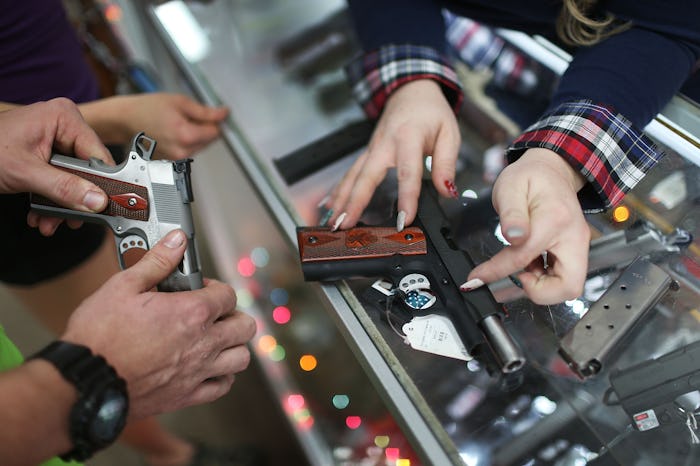News

Spike In Gun Sales After Sandy Hook Meant More Accidental Deaths, Too
This week marks the five year anniversary of one of the most devastating mass shootings in modern history. On Dec. 14, 2012, a gunman entered Sandy Hook Elementary School in Newtown, Connecticut and went on a shooting spree, killing 20 children and six adults before taking his own life. But the number of deaths inadvertently related to that day’s horrific events may actually be much higher. According to a MinnPost report, a new study published this week found that the spike in gun sales after Sandy Hook — and the subsequent rise in the number of guns in people’s homes — was directly related to a rise in accidental gun deaths in those households in later months. And, as one might imagine, the rate of accidental deaths jumped most sharply for children, according to the report.
For the study, Wellesley College economists Phillip Levine and Robin McKnight examined data from the Centers for Disease Control for the five months immediately following the shooting at Sandy Hook. Between December 2012 and April 2013, the nation was in heated debate around gun control, MinnPost reported. For example, in December 2012, then-President Barack Obama made an impassioned plea for “more meaningful action” to prevent the next mass shooting, and then in April 2013 Congress rejected Obama’s plans to overhaul gun policy.
According to the research summary in Science, Levine and McKnight found that the number of accidental gun deaths were higher nationwide in the five months after Sandy Hook than for that same period of time between 2008-2015. The data showed 57 more accidental gun deaths within that time (a 27 percent overall increase) and that 18 of those deaths were children (marking a 64 percent increase). Their data also showed that consumers bought 3 million more guns — almost 1,000 guns for every 100,000 people in the United States — within five months of the Sandy Hook massacre, according to the research findings.
But then, Levine and McKnight went a step further and actually mapped where the accidental deaths had occurred, according to the MinnPost report. They found that accidental deaths were concentrated in states where gun sales saw the highest rise after Sandy Hook, including Washington State, Montana, Minnesota, Tennessee, and Oklahoma.
What’s more, analyzing Google searches for those areas suggested that more of those sales were to people who never owned guns, or were pulling an already-owned gun out of storage. The MinnPost reported that the researchers found more searches that involved phrases like “buy gun” (as in, “where can I buy a gun”) and “clean gun” (as in, “how often should I clean my gun?”).
The idea that gun sales would spike after a mass shooting is (sadly) well documented. An analysis published in The Atlantic earlier this fall pointed out the gruesome way that gun companies’ stock prices rise after a shooting. The Atlantic reported a rise in gun sales and stocks after the shooting in San Bernadino, after the mass killing at Pulse nightclub in Orlando, and after a gunman opened fire on concertgoers in Las Vegas earlier this year. But this latest study, set to be published in Science, would be the first time that researchers connected that well-observed pattern to a subsequent rise in accidental shootings in areas that saw in uptick of gun purchases.
And so, it’s not surprising that gun advocates have already gone public to dispute the findings. For example, in a separate article for Science, Florida State University criminologist Gary Kleck pointed out that the 3 million guns at issue in the study represent just 1 percent of the 300 million guns currently under private ownership in the United States and couldn’t, he argued, be responsible for a 27 percent rise in accidental deaths. Other critics cited in that same report pointed out that the research was limited by flawed data on how many people actually own guns in the United States.
Five years after a shooter took the lives of more than two dozen people at Sandy Hook Elementary School (most of them children just 6 or 7 years old), the debate around the possibility of common-sense gun reform in the United States still rages on. As this latest study points out, the predictable uptick in gun sales after a mass shooting doesn’t mean fewer mass shootings in the future. Or, to be fairer: that's not all that a rise in gun sales could mean for a community.
Gun buyers acting after a mass incident may be looking to protect themselves from possible legislation that could make getting a gun more difficult, or responding to a real and deep need to protect their loved ones in the face of danger. Or they simply may be looking to exercise their constitutional right to own a gun. But, as this research points out, those decent intentions can come with dangerous, unintended casualties. Any responsible conversation about reform should examine the indirect consequences of gun ownership, too.